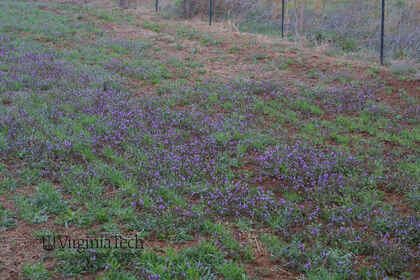henbit deadnettle
Family
LamiaceaeScientific Name
Lamium amplexicauleOther Common Names:
henbit
Synonyms (former Scientific Names):
Lamium amplexicaule var. album
Habit
Low growing winter weed with erect flowering stems that usually grow to about 10 to 25 cm tall (may reach 15 inches or 38cm). Stems are square and four-sided. Seedlings emerge in fall and early spring. Flower production may start in the fall but predominately occurs in spring and early summer. Plants completely die during hot summer months.
Leaves
The oppositely arranged leaves are round or wider than long with numerous rounded teeth. Leaves lack stalks (petioles) and tend to project at right angles to the stem. The entire plant is usually sparsely hairy.
Identifying Characteristics
Henbit has square stems and opposite leaves with rounded teeth. Plants produce characteristic mint-like flowers that are pink to purple; however, it does not have the characteristic smell like other members of the mint family. It can be confused with purple hen bit, but Henbit deadnettle has smaller leaves that are more lobed.
Flower Seed Head
Flowers are pink to purple and arise from leaf axils near the tip of erect stems. Flower parts are united into a two lipped tube. The inside of the tube has purple splotches.
Seed Fruit
Seeds are brown to light brown with lighter speckles. Seeds are about 2 mm long and have two angular flat sides and a rounded back.
Where Found
A common weed of lawns and other turfgrass areas, plants are often noticed after flower production starts in the spring. Plants are also common in home gardens, nursery crops and other agricultural crops.
Growth Habit
upright and nonwoody
Thorns or Spines
not present
Approximate Flower Diameter
Varies:
pencil,
dime
Dominant Flower Color
purple
Flower Symmetry
bilateral symmetry
Leaf Hairs
has hairs
Leaf Shape
Varies:
round,
heart,
oval
Leaf Arrangement
opposite
Leaf Margin
lobed
Leaf Structure
simple
Leaf Stalk
shorter than leaf
Stem Hairs
has hairs
Stem Cross Section
square or multi-edged
Milky Sap
not present
Root Structure
fibrous
Life Cycle
winter annual
Ochrea
not present
Plant Type
Herb








